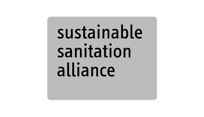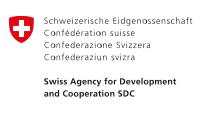Large-sized motorised vehicles such as trucks are ideal for long-distance and the bulk transport of waste. Due to their size and limited manoeuvrability, they are preferably combined with primary collection using smaller vehicles. The limited availability of suitable trucks, challenging road conditions, high costs and maintenance needs limit their use in some humanitarian contexts.

Large-sized motorised vehicles such as trucks have high payloads but limited manoeuvrability. This makes them ideal for secondary transport, which collects waste from transfer stations C.5 and hauls it to often distant treatment and disposal facilities. A collection from household, communal or public storage is only feasible if roads are wide and strong enough to support the weight of full trucks. Large-sized waste transport uses different types of trucks according to the needs. Trucks have different weight categories and types of vehicle bodies such as high-sided open-top trucks, trucks with closed storage compartments and compactor trucks. Trucks can be customised with separate compartments to transport segregated waste. The advantage of large payload trucks needs to be balanced with their increased costs, more complex operation and greater risk of work interruptions due to high vehicle maintenance needs and smaller fleet sizes.
Design Considerations
The selection of large-sized motorised vehicles for waste transport must consider local conditions such as road width and quality, transport distances, waste amounts and local market availability. Using locally available and widely used trucks facilitates maintenance and repair. Imported vehicles may not be adapted to the width, strength and condition of the roads and local maintenance and repair might not be possible. Trucks require mechanical lifting and emptying systems as well as compatible containers (unless waste is collected directly from households). Manual loading of large waste quantities must be prevented to ensure productive vehicle usage and occupational safety. Compactor trucks are rarely feasible in humanitarian settings as waste density is often high due to high levels of organic waste. Further compaction is therefore not required or its benefits are offset by the weight of the compaction mechanism and reduced payloads.
Materials
A truck’s waste storage compartments must be resistant to the potentially corrosive nature of waste. Cleaning can be challenging, especially in bigger or closed compartments; this increases the risk of corrosion. Vehicles are likely to be exposed to difficult road conditions; frequent stops during collection routes add to wear and tear. In humanitarian settings with often limited means for maintenance and repair the selection of simple, sturdy and long-lasting vehicles and engines is recommended.
Applicability
Large-sized motorised vehicles can be used in all intervention phases, from emergencies to protracted and development contexts. They are ideal for long distance and bulk transport. Collection from household, communal and public storage is also possible but requires sufficient vehicle access. This might be found in some urban contexts with larger access roads and in sparsely populated and widely extended settlements. Existing road strength and quality are important considerations for large truck use, especially during rainy seasons or other harsh weather conditions, as fully loaded vehicles can be very heavy. The trucks must be available to buy locally and local maintenance and repair services must exist.
Operation and Maintenance
The number of large-sized motorised vehicles in a fleet is typically small compared to other transport modes; the failure of a single vehicle therefore has a greater impact on overall service performance. The detailed planning of routes is essential to ensure a productive fleet that provides equal service to all service recipients, ensures accessibility for the trucks and bypasses potential traffic jams. Maintenance, repair and fuel availability must be ensured at all times to prevent the breakdown of collection and transportation services. Truck drivers must be well-informed about collection and transport routes and trained in safe and low-wear driving. During trips, drivers must be able to carry out minor technical troubleshooting in case of engine or vehicle failure.
Health and Safety
Especially for trucks with open storage compartments and on trips at higher speeds, waste loss during journeys must be prevented. Waste can be fastened down in vehicles with tarpaulins or nets. For longer journeys accommodation for the crew on the vehicles should be considered. Riding on waste must be avoided. Riding on rear platforms is only acceptable for short distances and slow speeds. Operators of vehicles with hydraulic lifting, emptying or compacting mechanisms must be properly trained to make use of these features and to prevent damage to the mechanism. The reversing of trucks must be avoided whenever possible or assisted by waste operators. Operators must wear personal protective equipment and be trained in correct waste handling and other occupational health and safety measures X.4.
Costs
Large trucks for waste collection and transport are the most expensive of all transport modes. Their use is therefore only reasonable if other transport modes have significant disadvantages in a particular context. Capital costs include the initial investment and the replacement costs once the equipment or entire vehicle reaches its end-of-life. The more specialised a truck, e.g. with lifting or compacting mechanisms, the more expensive it is. High operational costs are caused by high fuel consumption and the need for regular and complex maintenance. Operational costs can be reduced if truck usage is limited to specific and appropriate transport segments, e.g. secondary collection.
Social Considerations
Fast vehicle loading is critical to improved productivity of motorised vehicles. Therefore communities need to be well informed about collection times if such vehicles are used for household waste collection. Large-sized motorised vehicles require skilled drivers who might be in short supply and difficult to recruit if drivers are unfamiliar with the selected vehicles.
Key Decision Criteria
Input Products
Organic Waste
Organic Garden/Wood Waste
Organic Food/Kitchen Waste
Recyclables
Plastics
Paper and Cardboard
Metals
Glass
Textile
Mixed Waste
Residual Waste
Output Products
Organic Waste
Organic Garden/Wood Waste
Organic Food/Kitchen Waste
Recyclables
Plastics
Paper and Cardboard
Metals
Glass
Textile
Mixed Waste
Residual Waste
Response Phase
Application Level
Management Level
Space Required
medium
Technical Complexity
high,medium
Objectives & Key Features
Fast waste collection and waste transport over longer distances with larger amounts of waste
Strength & Weakness
- Ideal for heavy hauls over longer distances
- Highest payload of all transport modes
- High capital and operational costs
- Requires sufficient road width and strength
- Skilled drivers are required for safe and low-wear driving
Selected References
Key design features of the selection of large motorised vehicles
UNEP (2005): Solid Waste Management, United Nations Environment Programme, Kenya






